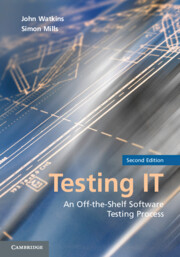Book contents
- Frontmatter
- Contents
- Foreword to the Second Edition by Geoff Thompson
- Foreword to the First Edition by Maurice Rosenburgh
- Acknowledgments
- 1 Introduction
- PART 1 THE TRADITIONAL TESTING PROCESS
- 2 An Overview of Testing
- 3 Testing Techniques
- 4 The Management and Planning of Testing
- 5 Unit Testing
- 6 Integration Testing
- 7 System Testing
- 8 Systems Integration Testing
- 9 User Acceptance Testing
- 10 Operations Acceptance Testing
- 11 Regression Testing
- 12 Improving the Testing Process
- 13 Introduction, Adoption, and Maintenance of the Testing Process
- 14 Agile Testing
- PART 2 THE TESTING PROCESS IN THE REAL WORLD: ILLUSTRATIVE CASE STUDIES
- PART 3 THE APPENDICES
- References
- Glossary
- Index
8 - Systems Integration Testing
Published online by Cambridge University Press: 03 May 2011
- Frontmatter
- Contents
- Foreword to the Second Edition by Geoff Thompson
- Foreword to the First Edition by Maurice Rosenburgh
- Acknowledgments
- 1 Introduction
- PART 1 THE TRADITIONAL TESTING PROCESS
- 2 An Overview of Testing
- 3 Testing Techniques
- 4 The Management and Planning of Testing
- 5 Unit Testing
- 6 Integration Testing
- 7 System Testing
- 8 Systems Integration Testing
- 9 User Acceptance Testing
- 10 Operations Acceptance Testing
- 11 Regression Testing
- 12 Improving the Testing Process
- 13 Introduction, Adoption, and Maintenance of the Testing Process
- 14 Agile Testing
- PART 2 THE TESTING PROCESS IN THE REAL WORLD: ILLUSTRATIVE CASE STUDIES
- PART 3 THE APPENDICES
- References
- Glossary
- Index
Summary
“There has never been an unexpectedly short debugging period in the history of computing”
– Steven Levy, “Hackers”Overview
The objective of systems integration testing is to provide confidence that the application under test (AUT) is able to successfully interoperate with other specified software systems and does not have an adverse affect on other systems that may also be present in the live environment or vice versa. Systems integration testing is conducted by the testing team under the supervision of the test team leader. Systems integration testing may also be termed compatibility testing or simply integration testing (as termed in the British Library testing process for example – see Chapter 15).
It is possible that the testing tasks performed during systems integration testing may be combined with system testing, particularly if the AUT has little or no requirement to interoperate with other systems.
Systems integration testing should employ black box techniques and will test high-level interoperability requirements of the AUT without considering the internal construction of the AUT (e.g., testing business processes and complete transactions that require intersystem communication or interaction). The use of negative testing and error guessing techniques (see Chapter 3) are particularly appropriate during compatibility testing for uncovering unanticipated problems.
In terms of the V Model, systems integration testing corresponds to the specification phase of the software development lifecycle (see Figure 8.1).
- Type
- Chapter
- Information
- Testing ITAn Off-the-Shelf Software Testing Process, pp. 70 - 76Publisher: Cambridge University PressPrint publication year: 2010

